It’s amazing how food can serve as a proxy for identifying key cultural integrations.
For the Chileans, the best available “yummy proxy” is none other than pastel de choclo. Drawing on key components from the different historical influences, this recipe represents far more than a corn pie for a fiercely proud population.
And, given the taste of it, we completely understand.

Pastel de Choclo via the Spaniards and the Mapuches
To understand all the cultural forces at play in pastel de choclo, it’s helpful for us to take a quick look at the past 10,000 years of history. Around this time, various tribes of Native Americans descended on the fertile valleys and attractive coastal areas that still constitute modern day Chile to these days. Over time, the leader of various tribes developed a fragmented (but still functional) coalition, a grouping known as the Araucanians.
For several millennia, the Araucanians were left alone (relatively speaking) until the spread of the Incan Empire in the 13th century. At this point, the Incans embarked on a massively ambitious campaign of cultural spreading, a campaign that certainly had its fair share of successes. With the Araucanians, the Incans had moderate success as well, although there was one subset of Araucanians in particular that offered effective resistance: the Mapuche.
In preventing further Incan spread, the Mapuche remained the dominant cultural force in southern and central Chile and even southwestern Argentina… up until the arrival of the Spaniards.
Arrival of the Colonial Era
Following several initial successful conquests into Peru, an expedition of Spanish conquistadors led by Pedro de Valdivia launched an expansion campaign into the lands of the Mapuche. Unfortunately for the Mapuche, their resistance proved to be less effective against the Spaniards, who took the lands easily and founded the city of modern-day capital Santiago.
The arrival of the Spaniards proved devastating for the Mapuche. As a result of repression, epidemics and the growing hostilities between the two, the population of the Mapuche was decimated between 1590 and 1598. Following the Great Uprising of 1598, however, the Mapuche regained their autonomy of lands south of the BíoBío River. Until another campaign of aggressive expansion that forged Chile’s modern-day boundaries in the 19th century, the Mapuche and the Spaniards slowly developed a semi-stable diplomatic and commercial truce between them.
But by the early 19th century, Chile had successfully broken off from the Spanish Empire and become an independent nation. Over the course of the next century, Chile saw an aggressive expansion of territory to form its modern boundaries. Between 1861 and 1881, this entailed a full annexation of Araucanian lands and a harsh integration of the Mapuche into Chilean culture.
For the Mapuche, this meant a massive population decimation (dropping from half a million to 25,000 people within one generation), a complete overhaul of their traditions and a relegation to peasantry in the new social standing.
Still, with the inclusion of the Mapuche and other immigrant cultures into the broader Chilean cultural spectrum, a new type of cultural intermingling resulted.
Which brings us to the rise of dishes like pastel de choclo.
Origins of Pastel de Choclo
By now, pastel de choclo is readily recognized as a ubiquitous favorite dish in all of Chile, and it’s a phenomenal resprsentation of mestizo (mixed) cooking.
What’s slightly interesting, however, is that pastel de choclo might have originally been a Peruvian invention. There are several mentions of a eerily similar decadent “corn pastry” being served at meals of the aristocracy during 17th century Peru, whereas mentions of pastel de choclo or pastel de maiz did not start surfacing in Chile until at least the 1830s. In fact, there’s very little mention of the corn pie recipe throughout the century, even as the Chilean food culture gained full stream and went fairly well documented.
As we’ll see more in depth later on, the common form of Chilean pastel de choclo essentially combined of the filling regularly used in Spanish-inspired empanadas covered by a corn “dough” coming from the popular Mapuche humitas. The recipe’s genesis is thought to have come from the kitchens of old colonial haciendas, where Mapuche cooks leveraged Spanish ingredients to create a more diverse eating experience for their rural communities.
The rise of pastel de choclo to Chilean prominence is presumed to have been triggered as part of a massive influx of economic migrants into Santiago, when the population grew from 190,000 in 1882 to ~400,000 in 1916. From here, a recipe mainly relegated to rural outskirts was thrust into cosmopolitan culture. By 1927, it had grown popular enough to appear in the first version of the US Congressional Club Cook Book as the representative dish from Chile.
And the rest, you could say, is history.
About the Recipe
In pastel de choclo, there are two key components to the recipe: the Mapuche-derived “corn dough” and the Spanish-derived filling.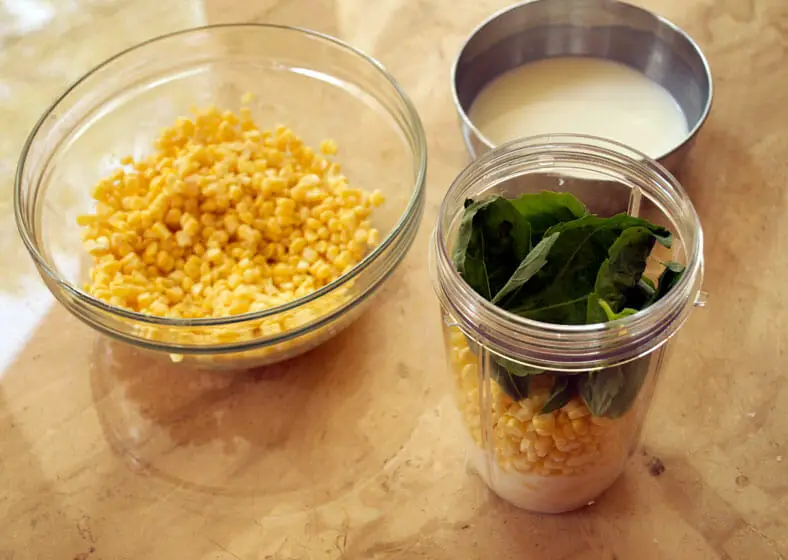
First, it’s best to start with the corn. After all, choclo is the Mapudungun (the Mapuche language) for corn. The base of this mixture is, at its most basic form, corn and milk. Additional ingredients and seasonings can be added here too, but corn and milk are the must-haves of the dish.
Together, these ingredients are simmered together and cooked to a point where the corn has softened a bit. The mixture is then either blended, whisked, food processed, or crushed together until you get a liquid with a thicker, mealy texture to it. In some cases (like ours), you can invert these two processes, but the result will end up the same. Once you’ve made this, you can set it aside for a bit.

Next, you’ll create your filling. You’ll see our slight variations later on, but most commonly pastel de choclo is made with a beef filling. If you make it this way, then you’ll want to start by sauteeing and cooking all your ingredients beforehand. Depending on which recipes you find, ingredients like garlic, onions, mushrooms and much more can be added, although the filling can also be made more simply with beef as well. The beauty of this dish is that it is completely up to you.
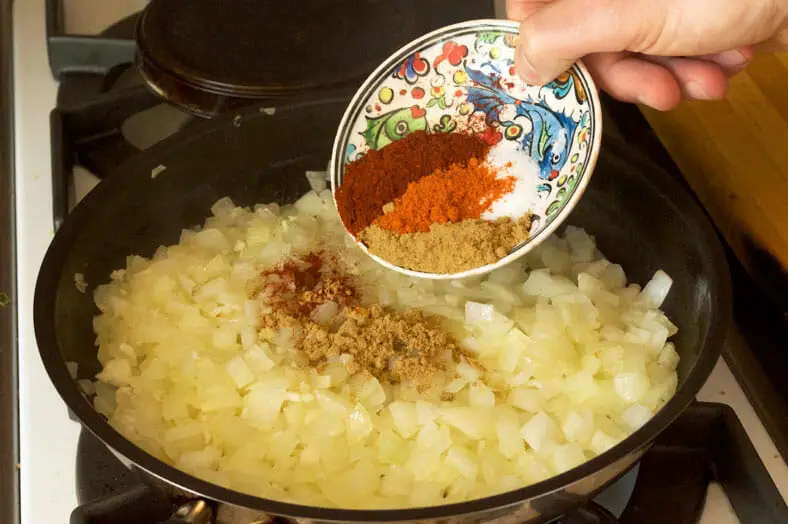
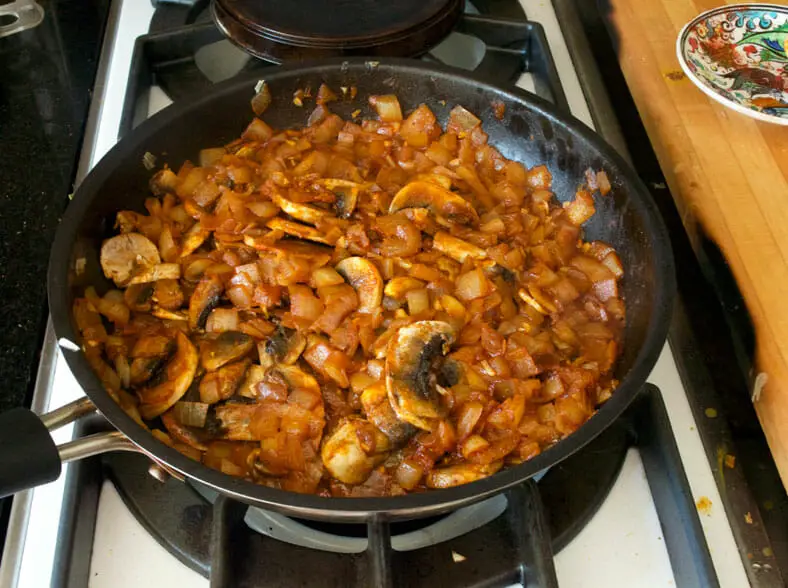

In addition to the cooked filling, there might be other ingredients added too. Again, depending on the recipe, you might see a calling for hard boiled eggs or raisins or olives. All of these have differing effects on the dish, all of which lead to delicious results.
Once you have your corn mixture and your filling ready, you’ll start with a greased baking pan into which you create the pastel, or “pastry.” You’ll start with a base layer of your corn dough followed by a layer of your filling, and you’ll alternate between layers until you’ve made your way to the top of your baking pan. Now again, some recipes will have a “filling first, then corn dough on top” approach, but the layering actually leads to a more elegant and even-flavored result.

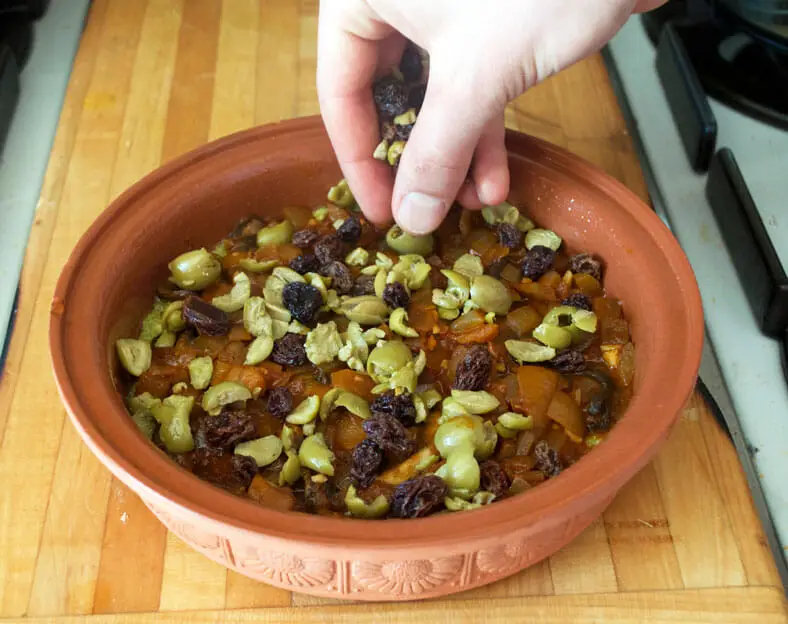

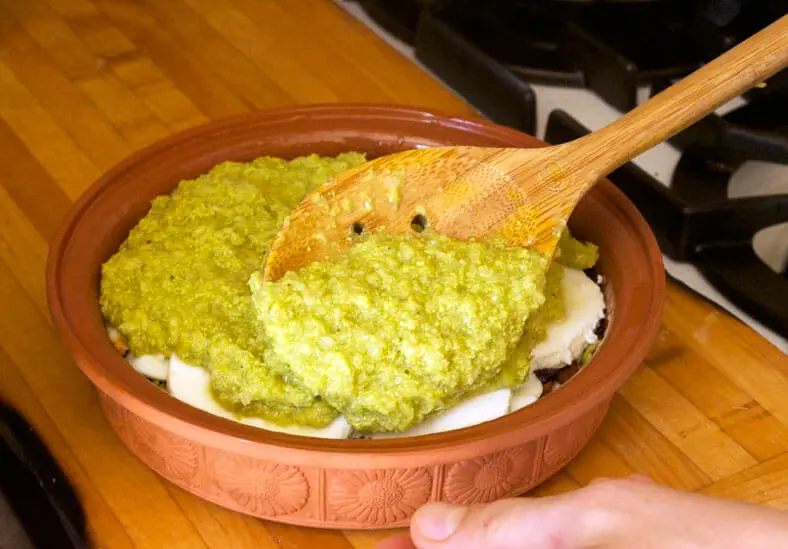
Finally, you might sprinkle a bit of sugar on the top of your pastel de choclo in order to get a caramelized flavor and a bit of a crunch at the top. Place into the oven for 30-35 minutes, and it’s done!
Our Take on the Recipe
For this recipe, it was particularly hard to chose which one to base our own off of since they were all so tasty in their own right. Nevertheless, this particular recipe stood out and thus served as our original reference.
We did, however, make some changes, most notably one to make this a vegetarian friendly dish. As delicious (for Cyrus) as the meat filling was, a vegetarian filling made with mushrooms was equally as satisfying and allowed us both to enjoy. Also added to the filling were spices like cumin and paprika to give an added zing to the flavor.
Another major change we made was to add mozzarella cheese to the dish. This isn’t a typical addition to most Chilean versions of the recipe, but you might very well find it included in certain regional variants or even in Ecuadorian or Colombian versions of the dish. It does, however, taste really good in the dish, which is why we added it to ours.
For the corn mixture, we did add an extra touch of fresh basil, which is why you’ll see our corn mixture come away as a little more green. More traditionally, the pastel de choclo will have a yellowish color to it, but the basil flavor comes out really nicely and was something we wanted to accentuate in ours.
And finally, as is the case with most of our recipes, we substituted regular sugar for coconut sugar. It’s our personal preference, and while it doesn’t have a prominent role in this dish, it’s always worth mentioning.

Other than that, pastel de choclo is a fabulous representation of intermingled culinary cultures… with delectable results.
Enjoy!
What filling would you add to your pastel de choclo? Comment below!
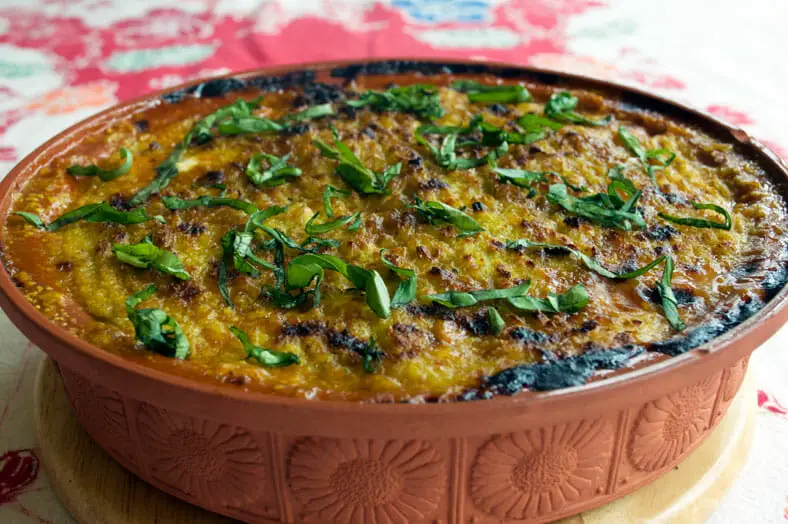

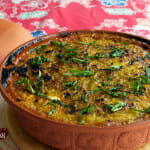
Pastel de Choclo
- Total Time: 1 hour 10 minutes
- Yield: 4 people 1x
Description
Pastel de Choclo with corn and milk.
Ingredients
Corn Mixture
- 6 ears of corn, peeled
- 1 cup of milk
- 1 handful of fresh basil
- 2 tablespoons butter
Filling
- 1 tablespoon olive oil
- ½ cup of mushrooms, sliced thinly
- 1 medium yellow onion, diced
- 3 garlic cloves, minced
- 1 tablespoon ground cumin
- 1 tablespoons paprika powder
Other Optional (But Recommended) Topping Ingredients
- 1 hard-boiled egg
- 2 tablespoons raisins
- ¼ cup pitted green olives
- 1 cup mozzarella cheese, either sliced or shredded
- 1 tablespoon coconut sugar
Instructions
Stage 1 – Create the Corn Mixture
- First, take a knife down your ears of corn to free the kernels from the cob
- In a blender or food processor (on Amazon), combine your corn, milk and basil. Blend or process until well combined into a semi-smooth, mealy texture. Try not to over-process and create too liquidy a mixture, though!
- Take a large stockpot over medium heat and melt your butter. Once heated, pour your pureed corn mixture into the pot
- Lower the pot to medium-low heat and cook your corn mixture for ~15 minutes. At this point, you’ll move onto making your filling, but be sure to occasionally stir the corn mixture and prevent any from sticking and burning on the bottom of the stockpot
Stage 2 – Prepare Your Filling
- While your corn mixture is simmering and thickening, take another saucepan over medium high heat. As the pan starts to heat up, add your olive oil
- Next, add your onions and garlic and cook for 3-4 minutes. The onions should begin to become translucent and fragrant
- Add the mushrooms and mix well. Cook for an additional 1 minute
- After 1 minute of cooking the mushrooms, add the ground cumin and paprika and mix well in. Cook for another ~3 minutes
- By this time, your corn mixture will have also simmered long enough to thicken considerably
Stage 3 – Assembling Your Pastel de Choclo
- Preheat the oven to 400 degrees Fahrenheit
- Taking a casserole dish, begin your pastel de choclo with a bottom layer of corn mixture
- Next, gently add a layer of your onion/mushroom filling followed by layering hard-boiled egg, raisins, mozzarella cheese and olive. Continue to layer until your filling ingredients are all up
- Cover your filling with all of your remaining corn mixture to the top of your casserole dish. Use a spatula to smooth it over
- Prior to placing your pastel de choclo in the oven, take a fork and comb small grooves into the top layer of the corn mixture
- Sprinkle a few pinches of coconut sugar over the grooves, then place your pastel de choclo in the oven
- Bake for 30 minutes, then turn on your broiler to the high setting
- Broil your pastel de choclo for another 5-7 minutes until the top layer has become a nice golden brown
- Take your pastel de choclo out of the oven, and enjoy!
- Prep Time: 10 mins
- Cook Time: 60 mins
- Category: Casseroles
- Cuisine: Chilean
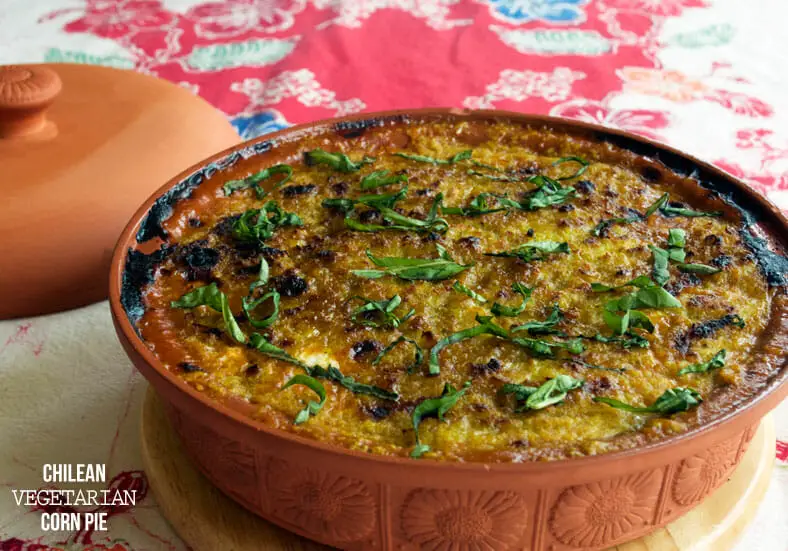

I actually have tried Chilean desserts (some caramel, sugar pie!) but never a main dish- This looks so good, and the inner kid in me is loving all the layers!!
Haha that’s awesome, Arman! And yeah.. the layers were a lot of fun to have 🙂
Question: is it important to use field corn or did you use sweet corn? This looks like so much fun!
Hey Laura, great question! We used field corn, although that’s more because we hadn’t thought of using sweet corn. I’m sure it will come out as delicious as the field corn version did. If you happen to try it with sweet corn, can you let us know?